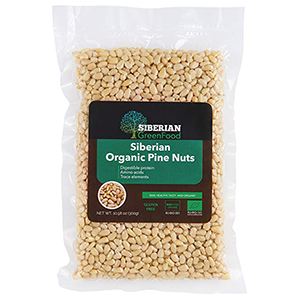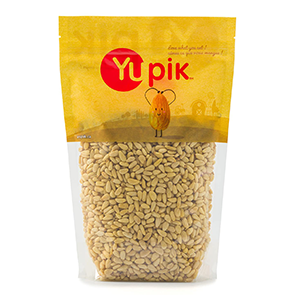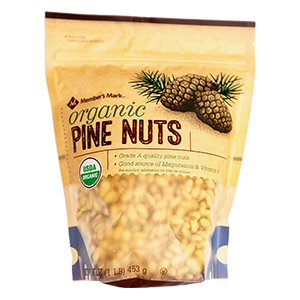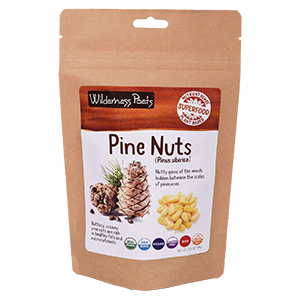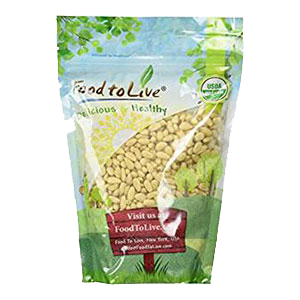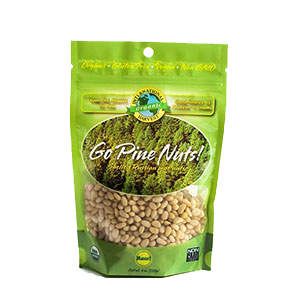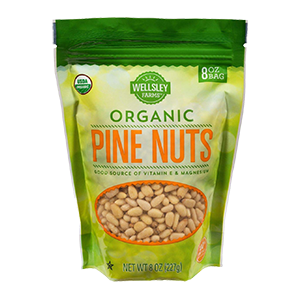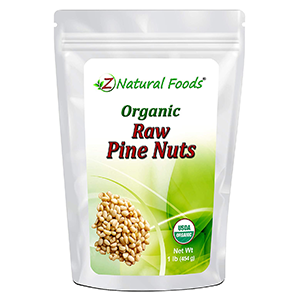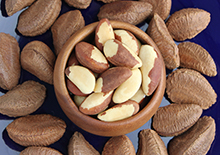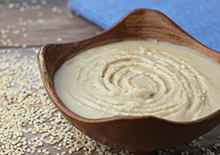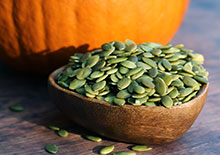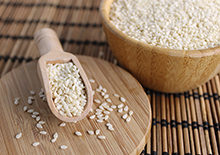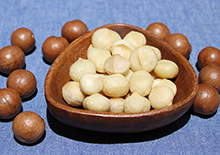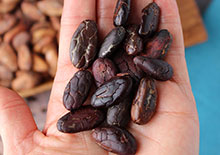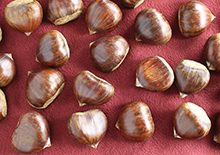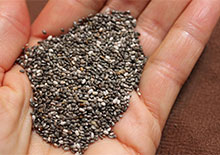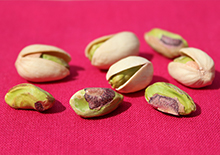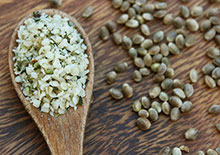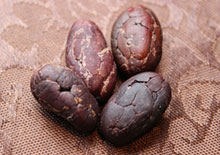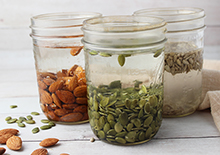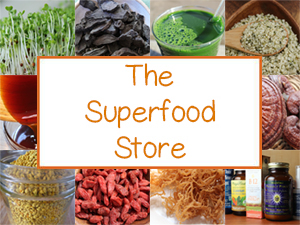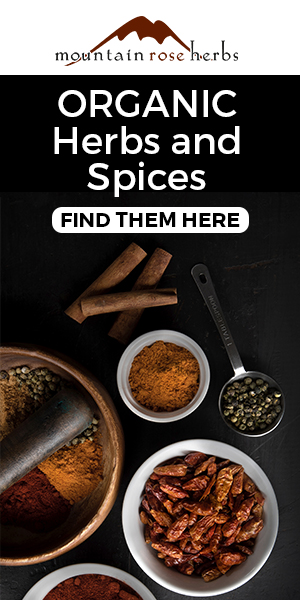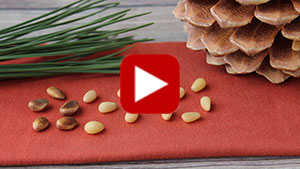About Pine Nuts and Their Nutritional Properties
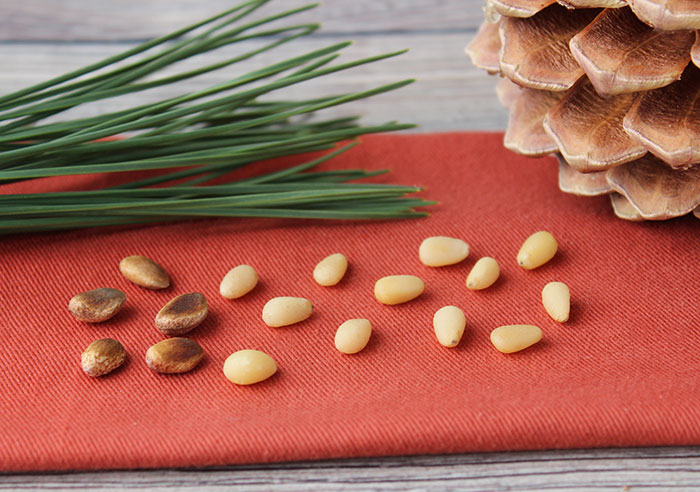
Pine nuts, also called piñon or pignolia, are the edible ivory-colored nut of the evergreen pine tree found inside the female pine cones that are typically ready for harvest in the fall season.
Here in the Sierra Nevada California foothills, during this time of year on a windy day, a pine cone laden tree may drop many seed-filled cones or the seeds will commonly fall to the ground themselves after the cones have opened.
The actual nut is surrounded by a firm but soft shell which rests on top of the cone scales, usually two per "petal". The unshelled seeds of many species, like the ponderosa or jeffrey pine, have an attached "wing" for their natural dispersal, while other types, like the popular stone pine native to the Mediterranean region, separate from the wing and simply fall to the ground as dark-shelled nuts.
In a non-scientific sense, the pine cone itself is like the "flower of the pine tree" and is actually the state flower of Maine. Species that we have collected can be full of sap and appear to be alive as they open and close according to fluctuations in sunlight and temperature just like any flower. The cone scales also interestingly are frequently known to be arranged in Fibonacci sequence creating a spiraling effect.
Pine trees, like walnut trees, are a long-living and hardy species, known to persist between 100-1000 years and sometimes beyond. Many commercial nuts produced can come from trees well over 100 years in age. One of the world's oldest recorded living organisms, is in fact a famous pine tree called the "Methuselah." Located in California's Ancient Bristlecone Pine Forest, it is reported to be 4,851 years old.
While pine nuts in a culinary sense are considered a NUT, botanically as a conifer gymnosperm species they are officially SEEDS as they are not encased within a fruit. In contrast to pine pollen, which is collected from male catkins, pine nuts are produced by female woody cones only. These are the seeds of the pine that will grow a new tree.
Pine nuts are a food source for wildlife like squirrels, chipmunks, birds, bears and wild boar. In many California pine forests, it is a very common occurrence to find a pine cone stripped of its petals by squirrels, who actively feast on the nuts and leave only the shells or cone fragments behind.
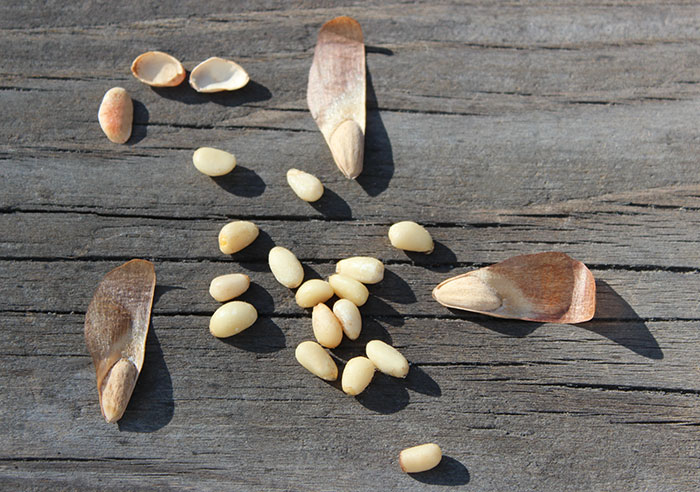
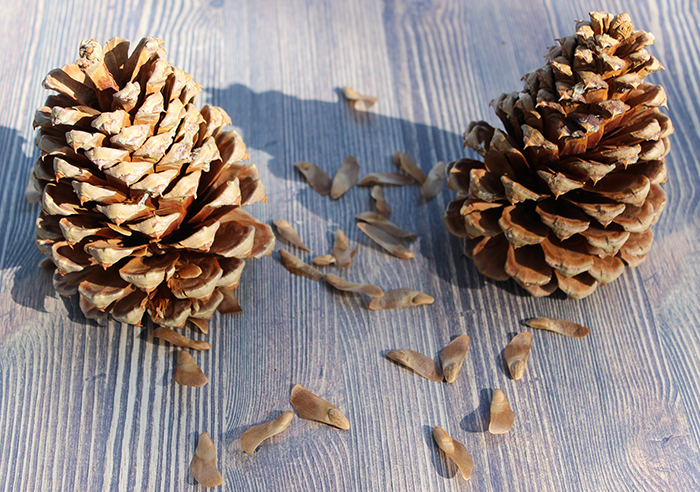
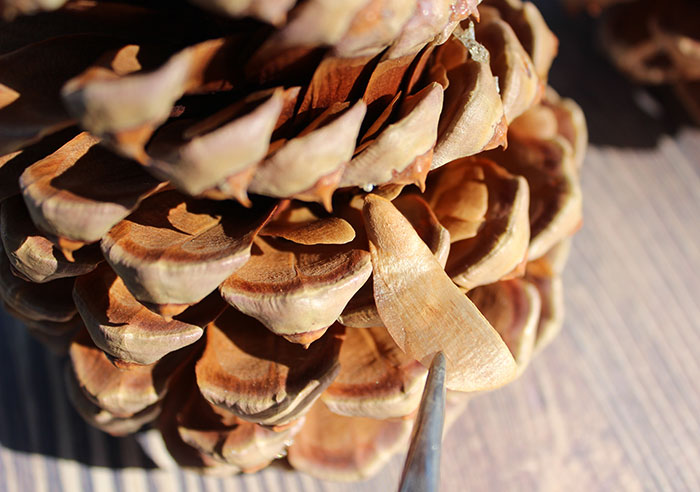
A Wild Dietary Food Source for Native Peoples
A long-time dietary staple for hunter-gatherer populations of the past for its sustaining nutritional content, the wild pine nut has been harvested by virtually every indigenous culture in alpine conducive habitats around the world.
In the Great Basin and Southwestern U.S., especially the Four Corners region, pine nuts from the pinyon pine species were an important food source for native Pueblo peoples such as the Navajo, Apache and Hopi.
Different Native American cultures of the Great Basin region, such as the Paiute, Shoshone and Washoe, likewise valued the pine nut as an important staple of their diet. Some sources say, "The pine nut was to the people of the Great Basin what the buffalo was to the plains people."
There are in fact still treaty negotiations in place that protect
tribal rights to harvest pine nuts in certain states, like Nevada. In
other areas like Great Basin National Park, public pine nut foraging
is allowed with a legal limit of 25 pounds per household.
Many indigenous cultures have their own traditional fall harvesting techniques. Sometimes the cones are knocked off the trees when green (then dried or scorched) or when brown. Other methods held strict beliefs that the seeds should only be collected after they naturally fell to the ground not upon forcing them. According to our research, in Navajo custom this was taboo and believed to "create an early winter", thus potentially shortening pine nut picking season.
Commercial Production of Pine Nuts
Pine nuts are one of the edible nut and seed varieties that can be harvested from wild locations or grown as a cultivated crop.
Although most all pine trees produce female pine cones that eventually produce pine nuts, not all of them are large enough or practical for human harvesting.
Of the close to 125 identified pine conifers in the genus Pinus growing in the Northern Hemisphere, only about 20 different species are harvested for their larger sized nuts.
The species most utilized for commercial production are:
- Siberian Pine (Pinus sibirica)
- Korean Pine (Pinus koraiensis)
- Stone Pine (Pinus pinea)
- Chilgoza pine (Pinus gerardiana)
- Chinese White Pine (Pinus armandii)
To date, most of the world's large-scale pine nut harvesting comes from Korea, Siberia, China, Pakistan, and Afghanistan.
Depending on the type, nut varieties can be long and slender or short and stubby.
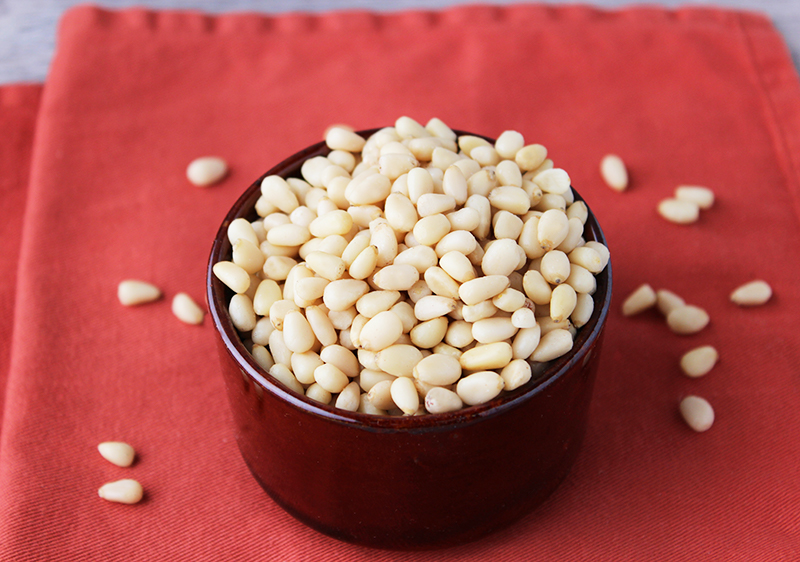
Why are Pine Nuts So Expensive?
Currently in the U.S., as of 2019, pine nuts average between $20-35 a pound (16 ounces) and are undoubtedly one of the most expensive of the nut and seed types. There are a combination of reasons why this is true.
As a food crop, certain species like the stone pine have been cultivated or grown plantation-style for centuries in the Mediterranean and Europe.
Other commercial producers, however, often harvest from naturally forested landscapes abundant in specific pine tree species. This can understandably make harvesting less efficient for mass production. Usually, these are pines, like the Siberian pine, that grow at higher elevations over 6,000 feet (1,800 meters) and experience a heavy winter snowpack to ensure good nourishment for the tree throughout the year.
In addition, pine nuts also have a long growing season, the time it takes for the cone itself to develop and reach full maturity can take between 18–24 months for most pines.
To top things off, as an overall species, pines and their nut production are known to be very unreliable from year to year. An abundant crop of cones with mature seeds in a wide regional range is known to average about every four years with other annual periods yielding much less.
Likewise, environmental conditions must be favorable for the cones to fully develop their seed or nuts. In recent times, changing weather patterns have notably disrupted pine nut growth and, at the same time, can make the trees vulnerable to insect infestation.
In some countries, such as the U.S., the pine nut industry over the years has been substantially affected by climate change and warmer temperatures. According to some of our findings, one Nevada state pine nut producer reports that the industry is on the brink of extinction.
All of these factors can help one to really appreciate the unique flavor of pine nuts the next time you eat them or use them in pesto. They are truly a gift from the pine tree and, in our opinion, worth the high price tag.
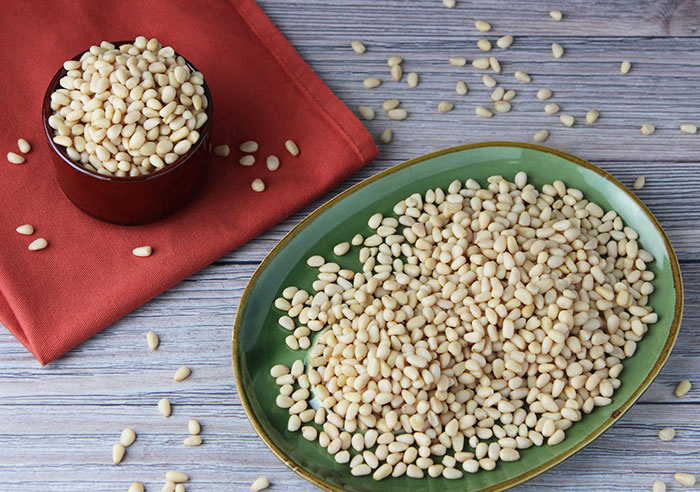
Pine Nut Nutrition Facts
Like tiger nuts, pine nuts can be considered a true "paleo" food as they have been consumed by humans since the Paleolithic period and were an important part of the hunter-gatherer lifestyle.
Pine nuts, depending on species and where they are produced, can vary in nutritional content.
Generally speaking, however, most are very high in MANGANESE, an important co-factor for the antioxidant enzyme, superoxide dismutase. They are likewise known to be high in VITAMIN K, which helps to promote strong bones, and LUTEIN, a carotenoid nutrient associated with maintaining healthy eyes. One ounce is reported to contain about 70.3 mg of MAGNESIUM or 18% RDV for adults on a 2,000 calorie diet.
Pine nuts are additionally a good source of vitamin E, thiamine, niacin, zinc, phosphorus, copper and iron.
A High Fat Food Source
Consumed in moderation, within a health-promoting diet, pine nuts with their oily meat can offer a good source of healthy fats as well as some protein. Their higher fat content and low carbohydrate ratio make them a good nut selection for ketogenic diets.
The oil in pine nuts is rich in PINOLENIC ACID, an isomer of GLA or gamma linolenic acid and an essential omega-6 fatty acid. Although they are high in PUFA's or polyunsaturated fats, compared to other types, most of this is coming from omega-6 fats which should ideally be balanced with appropriate ratios of omega-3 fatty acids. (*)
PINE NUT FATS
One Ounce
Total Fat - 19.3g - 30%
Saturated Fat - 1.4g, 7%
Monounsaturated Fat - 5.3g
Polyunsaturated Fat - 9.6g
Total Omega-3 fatty acids - 31.6 mg
Total Omega-6 fatty acids - 9410 mg
Potential Cardiovascular Related Benefits
The pine nut oil and its pinolenic acid content is identified in some research for its potential "LDL-lowering properties". In addition, the intake of magnesium-rich foods like pine nuts are associated with lowering cardiovascular disease related risk factors. (Source)
A staple selection on the Mediterranean diet, a small amount of pine nuts added to the diet can provide a heart healthy option to consider.
Do Pine Nuts Make You Gain Weight?
Pine nuts are an energy dense food and top on the list for calorie content after pilinuts, macadamia and pecans. According to nutrition data, one ounce (about 167 kernels) has approximately 188 calories which is largely from fat.
PINE NUT CALORIES
One Ounce
Total Calories - 188 (787 kJ)
Fat - 160 (670 kJ)
Protein - 13.3 (55.7 kJ)
Carbohydrates - 14.9 (62.4 kJ)
While generally all tree nuts are considered high calorie food sources, in some reviewed research, it has been observed that nuts don't necessarily stimulate weight gain as they can help to suppress appetite and increase thermogenesis.
Likewise, the nuts do not contain empty calories, but are full of nutritional content, such as the mentioned fat, protein, minerals, vitamins in addition to some dietary fiber. Consumed as a snack they can be a better alternative to other high-calorie but lower quality food choices.
Korean pine nuts are particularly known to contain higher amounts of pinolenic acid, averaging about 15% of total fatty acid content. In some research on post-menopausal overweight women given 3 grams of Korean pine nut oil with a light breakfast, was shown to release cholecystokinin (CCK), considered an appetite-suppressing hormone.
How to Use
Raw pine nuts have a soft texture as well as a buttery sweet flavor. They are extensively used in many different cultural recipes worldwide. Pine nuts can be used as a condiment to salads, many meals and even desserts. By far one of the most popular ways to use the raw nuts is as an ingredient in fresh basil pesto.
Some preparation techniques involve lightly toasting the nut to enhance the flavor and provide a crunchier texture. This will mostly likely destroy most of the nutrient content as well as polyunsaturated profile, but if nutrition is not on top on your list of priorities, you might enjoy this traditional practice.
Toasted pine nuts, combined with roasted coffee beans, are used to make the famous New Mexican "pine nut coffee".
Shelled raw pine nuts can go rancid because of their higher polyunsaturated fat ratio. It is therefore best to keep them in the fridge or freezer for storage purposes.
Precautions:
Pine nuts should, of course, be avoided by those who have tree nut allergies. It is best to avoid most nuts and seeds when treating a candida yeast infection. Consult your nutritionist or dietitian or health care advisor before consuming pine nuts on a regular basis if you are pregnant, nursing, taking prescribed medications or have a serious medical condition.
Shop Related Products (About Affiliates & Amazon Associate Paid Links)
Affiliate Disclaimer: This section contains affiliate product links. If you make a purchase through our recommended links, we receive a small commission at no additional cost to you. Thanks for the support.

